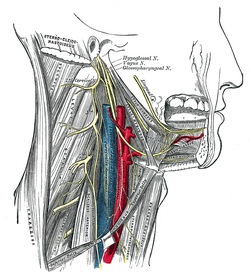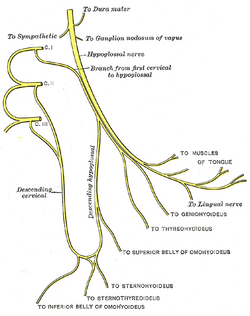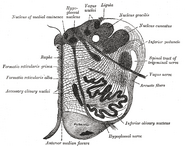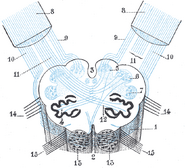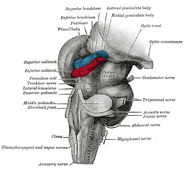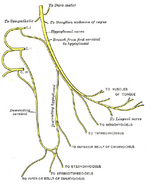| Nerve: Hypoglossal nerve | ||
|---|---|---|
| Hypoglossal nerve, cervical plexus, and their branches. | ||
| Plan of hypoglossal nerve. | ||
| Latin | N. Hypoglossus | |
| Gray's | subject #207 914 | |
| Innervates | genioglossus, hyoglossus, styloglossus, thyrohyoid, omohyoid, sternothyroid and sternohyoid | |
| From | ||
| To | ansa cervicalis | |
| MeSH | A08.800.800.120.330 | |
The hypoglossal nerve is the twelfth cranial nerve. The nerve arises from the hypoglossal nucleus and emerges from the medulla oblongata between the olive and the pyramids. It then passes through the hypoglossal canal. On emerging from the hypoglossal canal, the nerve picks up a branch from the anterior ramus of C1. It spirals behind the vagus nerve and passes between the internal carotid artery and internal jugular vein lying on the carotid sheath. After passing deep to the posterior belly of the digastric muscle, it passes to the tongue.
It supplies motor fibres to all of the muscles of the tongue, except the palatoglossus muscle which is innervated by the vagus nerve (X) and the accessory nerve (XI).
Aside from the tongue, the hypoglossal nerve also controls, via the ansa cervicalis, thyrohyoid muscle, omohyoid muscle, sternothyroid muscle and sternohyoid muscle. The nerve fibres supplying these muscles all come from the C1 contribution.
Testing the hypoglossal nerve[]
To test the function of the nerve, a person is asked to poke out their tongue. If there is a loss of function on one side (unilateral paralysis,) the tongue will point towards the affected side.
The strength of the tongue can be tested by getting the person to poke at the inside of their cheek, and feeling how strongly they can push a finger pushed against their cheek - a more elegant way of testing than directly touching the tongue.
The tongue can also be looked at for signs of lower motorneuron disease, such as fasciculation and atrophy.
Ipsilateral paralysis/pareisis of the tongue, results in contralateral curvature of the tongue (toward the unimpaired side of the mouth).
Additional images[]
External links[]
| This page uses Creative Commons Licensed content from Wikipedia (view authors). |
